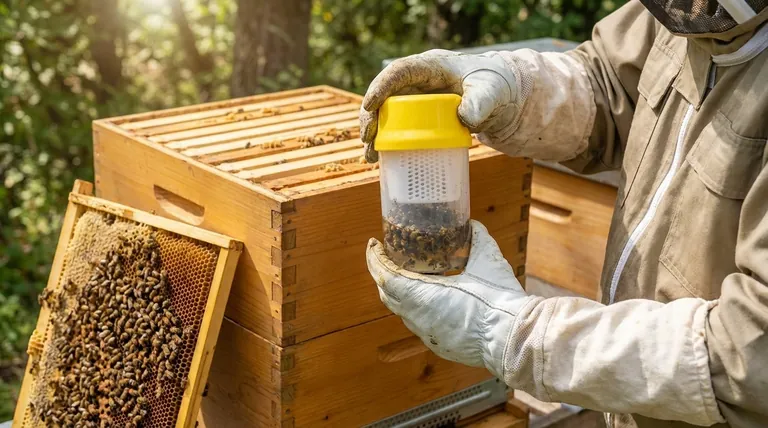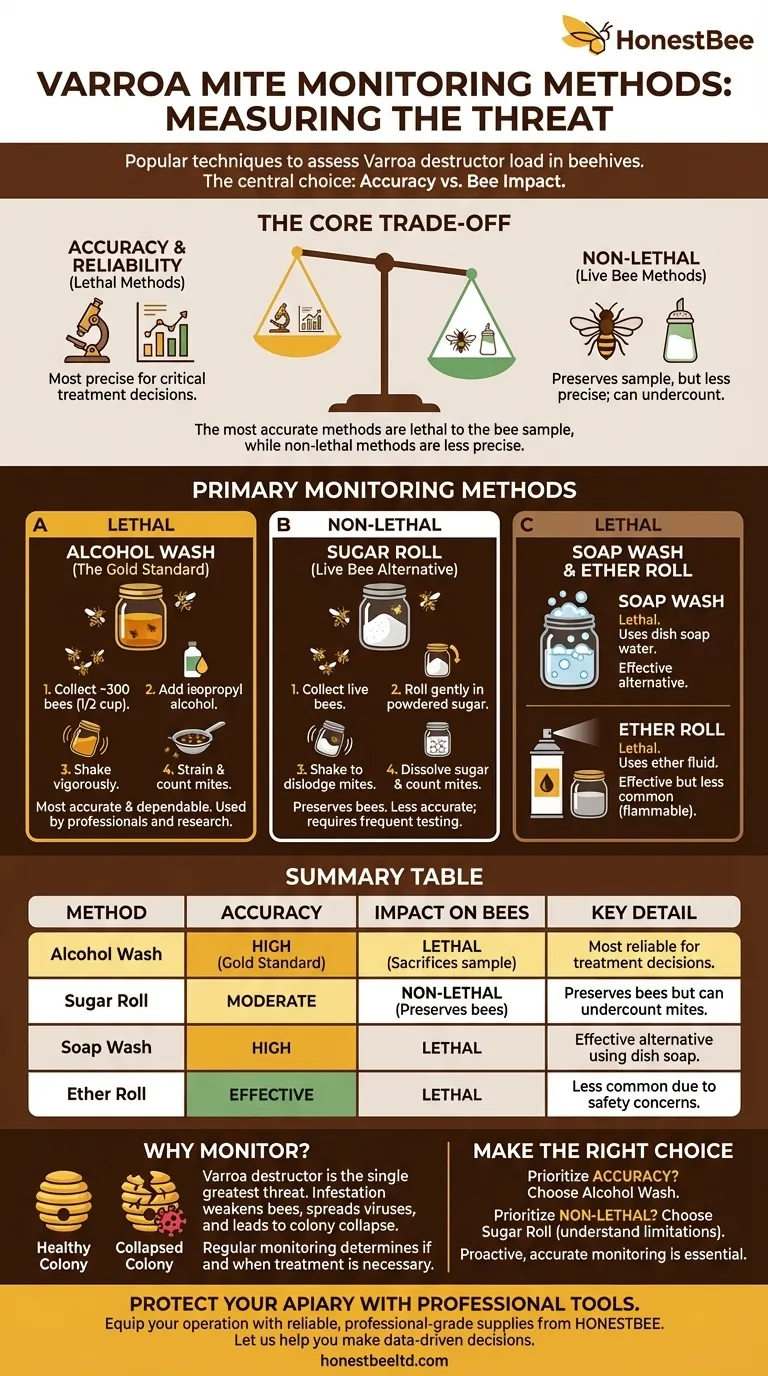The most popular methods for measuring Varroa mite loads in beehives are the alcohol wash, the sugar roll, and the ether roll. Each technique involves taking a sample of bees to dislodge and count the mites, but they differ significantly in their accuracy and their impact on the sampled bees.
The central decision in Varroa monitoring is not just which method to use, but accepting the fundamental trade-off: the most accurate and reliable methods, like the alcohol wash, are lethal to the bee sample, while non-lethal methods are less precise.

Why You Must Monitor Varroa Levels
The Varroa destructor mite is the single greatest threat to honey bee health worldwide. These external parasites weaken bees by feeding on their fat body tissue and transmit deadly viruses throughout the colony.
An infestation can appear manageable one month and lead to a total colony collapse the next. Simply looking at a hive tells you nothing about the mite level; you must test specifically for it.
Regular monitoring allows you to understand the level of infestation and determine if and when treatment is necessary. Managing what you measure is the cornerstone of modern, responsible beekeeping.
The Primary Monitoring Methods
Choosing a monitoring method requires understanding how each one works. The goal is always the same: separate mites from bees so you can get an accurate count.
The Alcohol Wash (The Gold Standard)
The alcohol wash is considered the most accurate, reliable, and consistent method for measuring Varroa mites. It is the standard used by commercial beekeepers, apiary inspectors, and research scientists.
The process involves collecting a precise sample of bees (typically 1/2 cup, or about 300 bees) in a jar, adding isopropyl alcohol, and shaking the container to dislodge the mites. The mites are then strained and counted.
This method is lethal to the sampled bees, but it provides the most dependable data for making critical treatment decisions. Devices like the Varroa EasyCheck are designed to simplify and standardize this process.
The Sugar Roll (The Live Bee Alternative)
The sugar roll is the most popular non-lethal method. It is preferred by beekeepers who are unwilling to sacrifice a sample of bees for testing.
In this technique, a sample of live bees is gently rolled in powdered sugar. The fine sugar particles irritate the mites and cause them to lose their grip on the bees.
After shaking, the bees are returned to the hive, and the sugar is dissolved in water to reveal the dislodged mites for counting. While it preserves the bees, this method is known to be less accurate than an alcohol wash.
The Soap Wash (A Variation on Alcohol)
A soap wash functions identically to an alcohol wash but uses soapy water (e.g., from a squirt of dish soap) as the agent to dislodge the mites.
Like the alcohol wash, this is a lethal method for the bee sample. It is effective and uses readily available materials, making it a practical alternative if you do not have isopropyl alcohol on hand.
The Ether Roll (A Less Common Method)
The ether roll uses an aerosolized starting fluid (containing ether) to quickly anesthetize the bees and dislodge the mites.
A sample of bees is sprayed in a jar, which is then shaken to knock the mites off. This method is effective but has fallen out of favor due to the highly flammable nature of ether and the availability of safer, more standardized methods like the alcohol wash.
Understanding the Trade-offs: Accuracy vs. Bee Mortality
Your choice of method hinges on a single, critical decision point. Acknowledging this trade-off is essential for effective hive management.
Accuracy Is Paramount
The primary reason scientists and professionals rely on the alcohol wash is its superior accuracy. An inaccurate, low mite count from a less reliable test can give you a false sense of security.
Making a decision not to treat based on faulty data is far more dangerous to the colony than the loss of a few hundred bees from a proper test.
The Cost of a Sample
Losing 300 bees from a test can feel significant. However, a healthy summer colony contains 50,000 to 60,000 bees, and the queen can lay over 1,500 eggs per day.
The loss of a 300-bee sample is a negligible sacrifice to protect the health and survival of the entire colony. It is an investment in actionable data.
Making the Right Choice for Your Apiary
Your approach to beekeeping will guide your choice of monitoring method. Be clear about your primary goal to select the best tool for the job.
- If your primary focus is maximum accuracy and data reliability: Choose the alcohol wash. It is the industry gold standard and provides the most trustworthy information for making treatment decisions.
- If your primary focus is avoiding any harm to individual bees: Choose the sugar roll, but understand its limitations. You must test more frequently and be prepared to act even if counts seem low, as the method can underreport the true mite level.
Proactive and accurate monitoring is the most powerful tool you have to ensure your bees thrive.
Summary Table:
| Method | Accuracy | Impact on Bees | Key Detail |
|---|---|---|---|
| Alcohol Wash | High (Gold Standard) | Lethal | Most reliable for treatment decisions |
| Sugar Roll | Moderate | Non-Lethal | Preserves bees but can undercount mites |
| Soap Wash | High | Lethal | Effective alternative using dish soap |
| Ether Roll | Effective | Lethal | Less common due to safety concerns |
Protect Your Apiary with the Right Tools
Accurate Varroa mite monitoring is essential for colony health. Equip your operation with reliable, professional-grade supplies from HONESTBEE. We supply commercial apiaries and beekeeping equipment distributors with the wholesale-focused tools needed for effective hive management.
Let us help you make data-driven decisions to ensure your bees thrive.
Contact our wholesale team today for a consultation to discuss your specific needs and our product range.
Visual Guide

Related Products
- Varroa Easy Check Mite Tester Kit Counter Alcohol Wash Jar
- Langstroth Screen Bottom Board for Beekeeping Wholesale
- No Grafting Queen Rearing Kit: System for Royal Jelly Production and Queen Rearing
- HONESTBEE 24 Head Rotary Bottle Washing Machine
- Jenter Queen Rearing Kit Complete Set for Bee Breeding
People Also Ask
- How is the infestation percentage calculated after counting mites? Master Varroa Mite Monitoring
- What are the steps to perform an alcohol wash test after collecting the bees? A Guide to Accurate Varroa Mite Counting
- What is the most accurate method for monitoring varroa mites? The Definitive Guide for Beekeepers
- Why is an alcohol wash preferred over powdered sugar rolls? For Accurate Varroa Mite Management
- How often should varroa mite checks be performed using the alcohol wash method? Optimize Your Apiary's Health

















